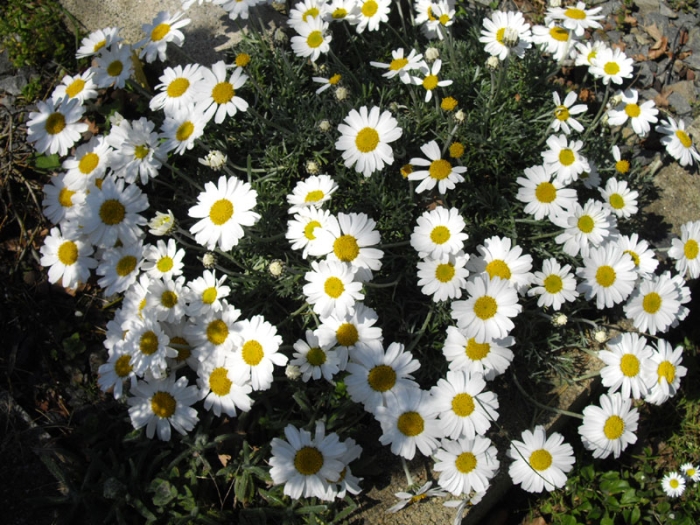Moroccan Daisy
(Rhodanthemum hosmariense)
Moroccan Daisy (Rhodanthemum hosmariense)
/
/

ghislain118 http://www.fleurs-des-montagnes.net
CC BY-SA 3.0
Image By:
ghislain118 http://www.fleurs-des-montagnes.net
Recorded By:
Copyright:
CC BY-SA 3.0
Copyright Notice:
Photo by: ghislain118 http://www.fleurs-des-montagnes.net | License Type: CC BY-SA 3.0 | License URL: https://creativecommons.org/licenses/by-sa/3.0 | Uploader: Ghislain118 | Publisher: Wikimedia Commons | Title: Chrysanthemum_mariesii_var_hosmariense_7.JPG |





Estimated Native Range
Summary
Rhodanthemum hosmariense, commonly known as Moroccan Daisy, is an evergreen perennial herb or subshrub native to the Atlas Mountains in Morocco. It thrives in rocky, mountainous regions and is well-adapted to dry, open areas. Moroccan Daisy typically grows to 30 cm (12 in) in height and width, forming a bushy, prostrate habit. Its deeply divided, silvery leaves provide a striking contrast to the solitary, daisy-like composite flower heads that bloom in summer. The flowers are showy with white petals surrounding a central yellow disc, attracting pollinators and adding visual interest to the garden.
Moroccan Daisy is valued for its drought tolerance and silvery foliage, which can provide year-round interest in the garden. It is an excellent choice for alpine gardens, rockeries, and as ground cover in sunny, well-drained areas. It has earned the Royal Horticultural Society’s Award of Garden Merit, indicating its exceptional performance in cultivation. This plant prefers full sun exposure and requires low amounts of water once established, making it suitable for xeriscaping. It is best grown in well-drained soil with medium fertility. While generally disease-free, it can be susceptible to root rot if overwatered or planted in poorly drained soils.CC BY-SA 4.0
Moroccan Daisy is valued for its drought tolerance and silvery foliage, which can provide year-round interest in the garden. It is an excellent choice for alpine gardens, rockeries, and as ground cover in sunny, well-drained areas. It has earned the Royal Horticultural Society’s Award of Garden Merit, indicating its exceptional performance in cultivation. This plant prefers full sun exposure and requires low amounts of water once established, making it suitable for xeriscaping. It is best grown in well-drained soil with medium fertility. While generally disease-free, it can be susceptible to root rot if overwatered or planted in poorly drained soils.CC BY-SA 4.0
Plant Description
- Plant Type: Herb, Subshrub
- Height: 0.3-1 feet
- Width: 1-2 feet
- Growth Rate: Moderate
- Flower Color: White, Yellow
- Flowering Season: Winter
- Leaf Retention: Evergreen
Growth Requirements
- Sun: Full Sun
- Water: Low
- Drainage: Medium
Common Uses
Bank Stabilization, Border Plant, Groundcover, Low Maintenance, Rock Garden, Salt Tolerant, Showy Flowers, Street Planting
Natural Habitat
Native to rocky, mountainous regions of the Atlas Mountains in Morocco
Other Names
Common Names: Atlaskrage
Scientific Names: , Rhodanthemum hosmariense, Chrysanthemum hosmariense, Leucanthemum hosmariense, Chrysanthemum maresii var. hosmariense, Chrysanthemum maresii subsp. hosmariense,
GBIF Accepted Name: Rhodanthemum hosmariense (Ball) B.H.Wilcox, K.Bremer & Humphries